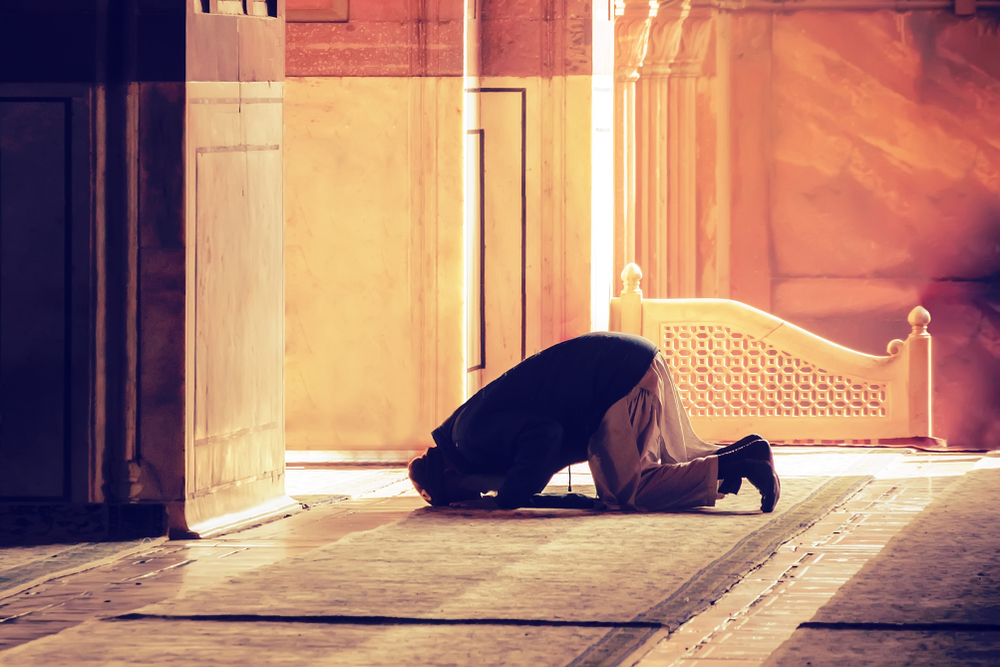Is It Mandatory to Straighten One’s Knees in the Standing and Bowing Prayer Postures?
Shafi'i Fiqh
Answered by Shaykh Irshaad Sedick
Question
Is it mandatory for the knees to be strictly straight in bowing (ruku‘) and standing (qiyam)?
Will a slight bend of the knees invalidate the prayer?
In the same way, is it mandatory for our backbone to be strictly straight during the sitting (iftirash and tawarruk)?
Answer
In the Name of Allah, the Most Merciful and Compassionate. May Allah alleviate our difficulties and guide us to that which is pleasing to Him.
It is not required, but recommended to have straight knees during the standing and bowing postures in the prayer, nor for the spine to be perfectly straight in the sitting postures of the prayer, as long as the fundamental forms of these postures are maintained, and Allah knows best.
Standing
Standing is an integral in all obligatory prayers (for anyone who can stand, whether by himself or assisted by another, though it is not integral in nonobligatory prayers).
Standing requires that the spine be upright. One is not standing if one inclines forward so that the backbone is no longer straight or bends so that one is closer to bowing than to standing. If a person’s back is bowed with age or the like so that this normal posture resembles someone bowing, he stands as he is but must bend a little further for bowing if able to.
In prayer, it is offensive to stand on one foot, for both feet to be held together (though this is sunna for women), or for one foot to be ahead of the other. To stand at length (reciting the Quran in prayer) is better than to prostrate or bow at length therein. [Keller, ‘Umdat al-Salik]
Bowing
Then one bows from the waist (an integral). The minimum is to bow as far as an average size person needs to when he wants to put his hands on his knees. It is obligatory that one repose therein, minimally meaning to remain motionless for a moment after having moved. It is also obligatory that one intend nothing by the motion but bowing. [Nawawi, Minhaj al-Talibin]
The optimal way is to raise one’s hands and say “Allahu Akbar” so that one begins raising the hands as one starts saying it, and when the hands are at shoulder level, one bows. Whenever one says “Allahu akbar” during a movement from one prayer posture to another, it is recommended to prolong the words until one reaches the next posture (so that one’s prayer is not devoid of invocation (dhikr) at any point).
Then one puts the hands on the knees, fingers apart, with back and neck extended, legs straight, and elbows out, though women keep them closed. [ibid.]
Sitting
Between the two prostrations, sitting is integral. It is obligatory to sit motionlessly for at least a moment and intend nothing but sit by one’s movement.
The optimal way is to sit in iftirash, placing the left foot on its side and sitting upon it while keeping the right foot resting on the bottom of its toes, heel up. Also, to place one’s two hands on the thighs near the knees, fingers extended and held together.
There are two other ways of sitting back (iq‘a’) between the two prostrations or the first and second Testifications of Faith (Tashahhud). One way is to sit back on the heels with the bottom of the toes and knees on the ground. This is recommended between the two prostrations, though iftirash is better.
The other way is to sit on the ground, palms down simply, and knees drawn up. This is offensive in any prayer.
During the final sitting posture in the prayer, one sits back (an integral) at the last of one’s prayer for the Testification of Faith in the tawarruk style of sitting, with one’s left posterior on the ground and left foot on its side, emerging from under the right side, which is vertical. The wisdom in the difference between the ways of sitting during the two Testifications of Faith, namely, iftirash in the first and tawarruk in the second, is that a latecomer to group prayer may know by observing the former that the prayer has not finished and by the latter that it nearly has.
I pray this is of benefit and that Allah guides us all.
[Shaykh] Irshaad Sedick
Checked and Approved by Shaykh Faraz Rabbani
Shaykh Irshaad Sedick was raised in South Africa in a traditional Muslim family. He graduated from Dar al-Ulum al-Arabiyyah al-Islamiyyah in Strand, Western Cape, under the guidance of the late world-renowned scholar, Shaykh Taha Karaan.
Shaykh Irshaad received Ijaza from many luminaries of the Islamic world, including Shaykh Taha Karaan, Mawlana Yusuf Karaan, and Mawlana Abdul Hafeez Makki, among others.
He is the author of the text “The Musnad of Ahmad ibn Hanbal: A Hujjah or not?” He has served as the Director of the Discover Islam Centre and Al Jeem Foundation. For the last five years till present, he has served as the Khatib of Masjid Ar-Rashideen, Mowbray, Cape Town.
Shaykh Irshaad has thirteen years of teaching experience at some of the leading Islamic institutes in Cape Town). He is currently building an Islamic online learning and media platform called ‘Isnad Academy’ and pursuing his Master’s degree in the study of Islam at the University of Johannesburg. He has a keen interest in healthy living and fitness.
